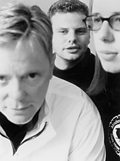THE SKEPTICS WHO, smirking, rode a wave of schadenfreude when 1997’s Dig Your Own Hole didn’t spark a conflagration on the Billboard charts can now commence eating their words. It’s official. Dance music—electronic, club, techno, downtempo, hip-hop, post-techno, or whatever’s your preferred terminology—has now transitioned from fashion to fixture. It’s matured to the stage of the third copy, and that means it’s here to stay.
Delta bluesmen got the ball rolling for rock. They inspired (or were exploited by) Elvis, the Beatles, and the Rolling Stones, who in turn inspired a thousand American garage bands, which then inspired punk rock. Ever since this culminating moment, rock musicians have been reinventing the wheel, waiting for the next paradigm shift.
Dance music’s Son House is iconoclastic classical composer Karlheinz Stockhausen. Kraftwerk turned his experimentalism into pop music, and then everyone from Juan Atkins to Afrika Bambaataa found inspiration in the glacial rush of their 808 beats and detached, elliptical vocals. For a brief moment in the ’80s, electro-morphing even hit the American pop charts, with Herbie Hancock’s “Rockit” and Art of Noise’s “Close (to the Edit).” In the clubs, tracks from Cybotron (Atkins’ first pseudonym), World Famous Wreckin’ Cru (Dr. Dre’s pre-gangsta incarnation), and the like had everyone popping and locking. Eventually, however, samples from rock records replaced synthesized beats as hip-hop’s mainstay, and Detroit techno stepped away from funk and into darker, colder realms.
In the early ’90s, pop music had its next great paradigm shift—away from rock and toward the dance floor. Americans outside the NYC-LA axis resisted as long as they could, but in the past couple of years, they’ve started to come around. Now, with Vocoders becoming old hat, electro—the stuff that launched both hip-hop and techno—is motivating that crucial fourth generation. The list of electro enthusiasts and converts who released albums in 1999 stretches far and wide: Drexciya, Funkst�g, Khan, Luke Slater, Jega, and so on. Kraftwerk came out with a new mix of “Tour De France.” The cheeky, uniformed boy-toys in DMX Krew even reinvented electro for the ‘N Sync crowd.
THE CURRENT RESURGENCE began in 1997 with the re-release of a zillion Gary Numan records. Around the same time, the name of electro forebear Kurtis Mantronik issued from every young producer’s lips. Priority Records issued two CDs of seminal electro-funk tracks, and techno DJ Dave Clarke mixed two volumes of Electro Boogie for the Studio K7! label. This year, it’s the electro-tinged synth-pop of New Order that’s hit the spot, siphoned through the sensibilities of Les Rhythmes Digitales, Underworld, Leftfield, and of course the Chemical Brothers. As the dynamic dance duo proved with their Bernard Sumner collaboration, “Out of Control,” that rock/techno crossover we’ve all been waiting for already happened—16 years ago, when New Order issued “Blue Monday.”
Unlike the States, the home of krautrock and Kraftwerk never lost its love for electro, thanks to DJs like Hell and Sven Vath. But Germany’s most blatant electro homage yet comes in We’ll Never Stop Living This Way, the American debut of WestBam (a.k.a. Love Parade founder Maximilian Lenz). The dance floor-wrecking DJ/producer has fully digested New Order and Kraftwerk, but it’s Bambaataa he idolizes, incorporating part of his name (the “West” comes from Westphalia, his native region in Germany) and, under the moniker Mr. X and Mr. Y, collaborating with Bambaataa’s son, Afrika Islam.
The differences between the Arthur Baker and Egyptian Lover tracks that kids rocked in the ’80s and the electro of today begins with technology. Recent electro releases are more fluid than the chunky Roland 101 beats of yesteryear, even when it’s someone like Funkst�g aiming for “lo-fi” sound. Incorporating the styles that have come along since “Planet Rock,” current electro is more likely to get its funk element from acid house than from George Clinton’s mothership. At it’s most party-hearty, electro’s not even called electro: It’s been recast as New-Skool Breaks and championed by several small British labels, including five-year-old Botchit & Scarper. This strain hops genres in search of the perfect beat, resulting in stylistic m鬡nges like the new compilation United Breaks Nation.
On London-based producer Simon (Si) Begg’s Commuter World, released this year, he translates the suburban daily grind into slices of cold, sharp breakbeat (call it Trans-London Express). His most blatantly electro-influenced tracks have appeared under the name Buckfunk 3000, like his recent prickly, pitch-shifting contribution to Electric Kingdom: Episode One. This anthology of the biggest names in the new-skool breakbeat scene launches the electro space oddity into the millennium with ghostly reverberations (Thomas Krome’s “Electro Bitch”) and fetishistic, liquid beats (Nudge’s “Skewer [You’re So Human]”), conjuring the spirit of Kraftwerk and Bam all over again.
Why does electro sound so fresh? For one thing, producers are weary of rigid structural restraints. Whether house, trance, or trip-hop, most dance music has worked itself into a comfortable corner of four-on-the-floor thumps. Electro shatters this womb-like state with shocks of syncopation. Often criticized for being cold and computerlike, electro is actually the most human-sounding of techno genres; it takes a human to comprehend the concept of a future, and electro is musical futurism at its most optimistic.
Yet, in its turn-of-the-millennium incarnation, electro’s reached its fourth-generation plateau. Now it’s free to plunder the past with impunity, replacing invention with mastery, like pretty much every guitar-rock record made since 1976. Progress is overrated anyway, since you’re just as likely to end up in a cul-de-sac as in outer space.






